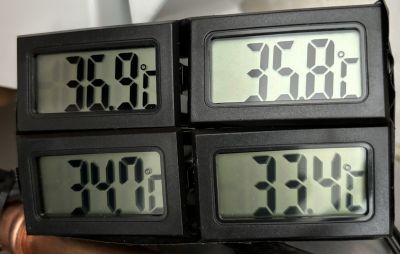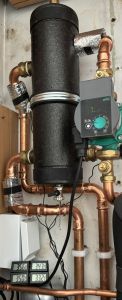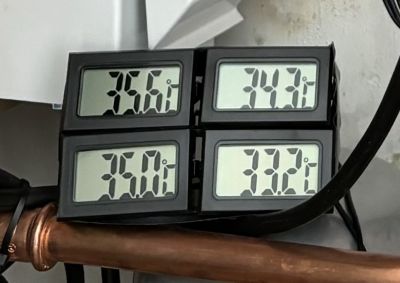Avoid the Heat Pump Villain: Why Low-Loss Headers and Buffers Can Sabotage Your Heat Pump's Efficiency
I purchased some LR44 button Cells and powered up the 4 sensors; I laid the four probes close together and placed a Govee thermometer on either side of this bundle of sensors. The Govees both indicated the same temperature and I left the whole caboodle for 5 days occasionally comparing the readings on all four sensors to the Govees. I found that two of the sensors were consistently 0.1 degree C low and 0.1 degree C high and the others were 0.9 and 1.1 degrees C lower than the Govees. The four displays were then taped into a little ‘block’ and the probes taped onto the LLH pipes and covered with insulation. I left the probes to settle for an hour and then read (as per the photo) the results. Top left and bottom left are the heat pump flow and return; the top right and bottom right are the flow from LLH to emitters and return respectively. The left hand displays are both within 0.1 degree of Govee reference and the right hand pair are 0.9 and 1.1 degrees of reference. Outside temperature (according to Daikin Onecta app) was 13 degrees C and heat pump and secondary pump are noth working. Any comments welcomed but I’ll see what results show when OAT becomes more winter-like. (One other thing, supplier has not supplied replacement button cells so have reported them to Amazon) Regards,, Toodles.
Toodles, heats his home with cold draughts and cooks food with magnets.
So applying the correction factors which you have established, the LWT is 37C and the RWT is 34.8C, giving a DT of 2.2C in the primary circuit. On the secondary side of the LLH the flow temperature is 36.7C and the return temperature is 34.5C, again indicating a DT of 2.2C.
The temperature drop across the LLH is only 0.3C, so I would assess that your system is operating in quite an efficient manner.
@derek-m Hello Derek, I have left the system running with the thermometers in place for a few weeks now; glancing at the readings from time to time indicates that the varying OAT’s for a constant IAT show that the differential is fairly consistent. The displays are: Top Left = Flow to LLH. Top right = LLH flow out to rads, Bottom right = Return from Rads and Bottom Left = Return from LLH to ASHP. With the correction factors of the two right hand displays being 1 degree C. lower when all sensors were bunched together for several days, I am applying a +1 degree to these two thermometer readings; though I know these are not super-accurate devices, I think they probably provide a reasonable indication of the trends of changing temperature at the 4 points. I seem to have an average drop of 0.2 - 0.3 degrees across the input from the flow to the output of the LLH and 0.3 - 0.6 degrees C. across the return to the LLH and the return to the ASHP.
From time to time, I notice a dynamic ‘blip’ from time to time where one display or the other might indicate perhaps a 1 degree difference but this is short lived usually. I even noticed a difference of 4 degrees momentarily where the flow into the LLH exceeded the reading on the flow out to the rads; this lasted about 30 seconds or so and I have no idea why this should happen.
I don’t know the make of LLH as no label is visible but it is approx. 46 cm. Tall and 17 cm. wide.
Observations welcomed please!. Regards, Toodles.
Toodles, heats his home with cold draughts and cooks food with magnets.
I suspect that the image was subjected to some filesize reduction so here is a close up of the displays. Toodles.
Toodles, heats his home with cold draughts and cooks food with magnets.
I believe that the temperature readings indicate that your system is quite well balanced, in that the flowrate into the LLH is slightly greater than the flowrate out to the radiators.
This is probably the optimum achievable situation, since the slight mixing that is taking place within the LLH is at the return flow end. Slight mixing of the return flow should not have a detrimental effect on heat pump operation and overall efficiency.
Thank you Derek, at least it is only a little ‘Devil’ then! Regards, Toodles.
Toodles, heats his home with cold draughts and cooks food with magnets.
Many of you may be aware of my growing skepticism towards certain elements of the heat pump, and one aspect I find particularly perplexing is the position held by both manufacturers and installers of heat pumps. This confusion was further compounded following my participation in an online discussion involving a group of installers and a representative from one of the leading heat pump manufacturers. The debate quickly escalated, especially around the topic of buffer tanks, reaching a point of intense contention. Interestingly, the manufacturer chose to remain notably silent as the installers, who were divided in their opinions, engaged in a heated exchange.
The crux of the debate revolved around whether buffer tanks could be installed efficiently and effectively by installers in general. The conversation revealed that integrating a buffer tank with a low temperature heat pump system, along with managing all related components, is a complex process. It became evident that a significant number of installers in the UK lack the necessary skills and training to execute such an installation successfully. Prompted by this realisation, I questioned why the industry doesn't move away from using buffer tanks altogether to avoid the complications associated with their installation.
This query led to an unexpected direct message from a high-ranking official within the manufacturing company, asserting their unequivocal support for the use of buffer tanks and their desire for these components to be incorporated into installations, regardless of the efficiency of the installation process. Needless to say, this was a private exchange, and a position they didn’t want to express publicly.
This admission was startling and left me perplexed about the overarching objectives of the heat pump industry. It begs the question: why are we installing advanced heat pump systems only to undermine their performance with suboptimal installations? Surely, the ultimate aim should be to ensure that we are installing the most efficient systems possible, rather than settling for setups that significantly impede their functionality.
Get a copy of The Ultimate Guide to Heat Pumps
Subscribe and follow our YouTube channel!
@editor Mars, as you might know, we have an LLH (which fortunately seems to be running with relatively low losses to the efficiency 😉). I am not about to rip out the LLH to extract a little more efficiency though! The majority of installers seem to opt for an LLH or a Buffer Tank by default as a ‘rear covering’ exercise don’t they? I had a long conversation with the director of the installers and he seemed to view the situation as a positive addition as it removed the necessity to achieve such a delicate setting of the Delta T performance from the secondary circuit that fed the emitters. I think our system is running well, but there is always the nagging feeling …’Might my Air Source Heat Pump run more efficiently if I had the LLH removed?’ Regards, Toodles.
Toodles, heats his home with cold draughts and cooks food with magnets.
The cynic in me says this is about reducing call-outs & guaranteeing adequate volume for defrost. From a customer POV, as well as having the potential to be poorly installed, a buffer increases cost and takes up space which many may not have.
It would be worth, IMHO, pressing them on the question of whether they mean 'buffer tank' or 'volumiser'. The latter at least has less potential for poor installation.
4kW peak of solar PV since 2011; EV and a 1930s house which has been partially renovated to improve its efficiency. 7kW Vaillant heat pump.
Is there also a danger in the terminology that is being used ie low loss header, buffer and volumiser. Not all LLH's act as buffers, correctly specified and installed they operate perfectly correctly as a hydraulic separator. It very much depends on where on the LLH the ports are positioned.
Are we in danger of vilifying an entire class of products?
Posted by: @abernyteIs there also a danger in the terminology that is being used ie low loss header, buffer and volumiser. Not all LLH's act as buffers, correctly specified and installed they operate perfectly correctly as a hydraulic separator. It very much depends on where on the LLH the ports are positioned.
Are we in danger of vilifying an entire class of products?
As far as I am aware there would be no problem with a LLH or buffer tank, if the primary and secondary flowrates can be balanced to ensure that no mixing of the flow and return takes place. Obviously balancing the flowrates becomes problematic if the heat pump controller is able to vary the primary flowrate, without the necessary adjustment also being performed on the secondary, thereby unbalancing the system.
Having an additional water pump that may not be necessary is also a possible waste of electrical energy.
-
British Gas Heat Pump Installation Complaint
2 months ago
-
Heating Turned Off but Radiators Still Warm
2 months ago
-
Samsung Heat pump with Yonos Pico circulating pump running all the time
3 months ago
-
Samsung 5kW R32 Monobloc Gen 6 ASHP
3 months ago
-
Ideal Logic 10kW Heat Pump Pipes Noisy and Very Expensive to Run
11 months ago
- 26 Forums
- 2,364 Topics
- 53.6 K Posts
- 287 Online
- 6,029 Members
Join Us!
Worth Watching
Latest Posts
-
RE: Octopus Cosy Heat Pump Owners & Discussion Thread
TRV heads do indeed close completely once room temp is ...
By JamesPa , 3 hours ago
-
RE: Ecodan unable to hit legionella target temp - what's the consensus?
UPDATE: Thanks everyone who commened with suggestions h...
By 9jwr9 , 3 hours ago
-
-
RE: ASHP sizing - value of Heat Transfer Coefficient
@toodles Hi, my friend recently made a video about heat...
By HeatPumpMe , 1 day ago
-

How long will your energy contract last?
Some heat pump tariffs don’t run as long as a heat pu...
By Toodles , 2 days ago
-

@morgan They are unsupervised these days, can’t get the...
By Toodles , 2 days ago
-
-

RE: Setback savings - fact or fiction?
Exactly. We only need to compare conditions, to decide ...
By cathodeRay , 3 days ago
-
RE: Balancing financial efficiency and comfort using the Octopus Cosy tariff
I found because I have very low heat loss I can set bac...
By RadWhisperer , 3 days ago
-
RE: Need Help Optimising My Rushed ECO4 Install: 12kW Bosch Heat Pump
Welcome @mickamills We too have an oversized 12kW Sa...
By Old_Scientist , 4 days ago
-
RE: My Powerwall 3 Consumes 3-4 kWh/Day in Self-Consumption: Is This Normal?
@caron I can confirm that the power usage of the PW3 is...
By Old_Scientist , 4 days ago
-
RE: Speedcomfort radiator fans
Thats true, but having tried (and succeeded) in constru...
By JamesPa , 4 days ago
-
RE: Solis S6-EH1P8K-L-PLUS – Why I Chose It and What I’ve Learned So Far
@bash brilliant, thanks for the feedback
By energy9165 , 4 days ago
-

RE: Heat Pump Heats the House… But It’s Not Cosy. Emitter Changes or System Tweak?
@alastair There I was, feeling grumpy, he said “Cheer u...
By Toodles , 4 days ago
-
RE: Grant Aerona: Is there a setting to keep the 2-port valve open during pump blockade
Depends on OAT. Mine cycles at OAT>10 and of course...
By JamesPa , 4 days ago
-
RE: New Fogstar 15.5kWh upright solution
@transparent My conclusion is as you have noted, tha...
By Bash , 4 days ago
-
RE: Mitsubishi Ecodan R290 10kW performance
And to you too. Wishing you a very enjoyable festive s...
By Sheriff Fatman , 4 days ago
-

RE: External pipework insulation
They do? But that isn't apparent from the photos we'r...
By Transparent , 4 days ago
-

RE: Say hello and introduce yourself
@velcro welcome to the forums. Please feel free start a...
By Mars , 5 days ago
-
Daikin EDLA11D3V3 DHW Settings
I have a newly installed EDLA11D3V3 which I'm still get...
By Velcro , 5 days ago









